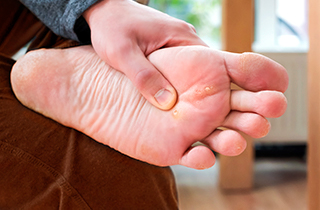
An Ounce
Of Prevention Is Worth A Pound Of Cure
There is a saying that goes: An ounce of prevention is worth a pound of cure or a stitch in time saves nine. However, we, as human almost always go against this theory. A very good example is that we tend to leave the house without an umbrella even though we know that it is likely to rain that day. Unlike this example as we could easily recover from a flu or fever after getting caught in the rain, once a crack formed on your heels, it takes a longer time for it to be completely cured. Therefore, it is always wise to do sufficient prevention than doing damage control after that.
Ellgy Plus Cracked Heel Cream is essentially a must-have item for everyone to prevent the formation of cracked heels. Indeed, there are many ways to make your walking more enjoyable, such as protecting your foot from rubbing against the shoe linings with silicone-lined socks and blisters prevention stickers. However, it is equally important to continue your healthy habits after a long day’s walk, which is to finish the day with a great moisturizer for your heels.
We apply sunscreen on our face and neck when we are under the sun. After we are done for the day and wash off what is remaining on our face, we apply moisturizer to keep our skin healthy. Same thing has to be enforced to our heels. We tend to undermine the importance of our heels as their appearance is hardly noticeable by everyone including yourself, but it is also one of the most important parts of our body as what keeps us moving daily is walking.
So who are most likely suffer from mild to severe cracked heels? Research has shown that diabetic patients are those that suffer consequential cracked heels and some may eventually lead to foot amputation. According to the National Health and Morbidity Survey, almost one in five Malaysian adults has diabetes
- Every 30 seconds, a leg is amputated due to diabetes in somewhere in the world
- However, diabetic foot amputation can be prevented with proper management of the diabetic foot.
Therefore, it is crucial for diabetes patients to take care of their foot before it is too late.
But let’s delve deeper to the issue. Aren’t us the potential victims of cracked heels? Our feet are in constant friction against the shoe linings and shoe soles. The skin on our feet are naturally dry as it has no oil glands to moisture our skin, which makes the formation of cracked heels easier. What is more, the average person takes 8,000 to 10,000 steps a day, which is equal to around 185,074 kilometers in a lifetime, that’s more than four times around the Earth.
With the advancement of public transportation around us, soon enough we will be less dependent on our cars but on our feet to move about within the stations. During an average day of walking, the forces on your feet can total hundreds of tons, equivalent to an average of a fully loaded cement truck. The pressure on the feet when running can be as much as four times the runner’s body weight.
Not just the diabetes patients need to take care of their heels, protecting our heels are essentially everyone’s duty. Start today, lay a solid groundwork with appropriate layer of protection on your heels before you start clicking away your heels!





